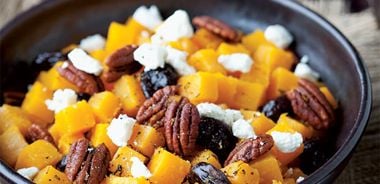Orange Glazed Butternut and Herbed Pecans

One taste of this autumnal side dish and you’ll surely be agog with excitement to make it again soon. Research shows that compounds in dried plums may improve bone strength, which may in turn help reduce fracture and osteoporosis risk.
2/3 cup (160 mL) pecans
1 tsp (5 mL) extra-virgin olive oil
1 tsp (5 mL) chopped fresh thyme
1 tsp (5 mL) chopped fresh rosemary
1/4 tsp (1 mL) paprika
1/4 tsp (1 mL) + 1/8 tsp (0.5 mL) sea salt
1 lb (450 g) butternut squash, peeled and cubed (about 4 cups/1 L)
1 Tbsp (15 mL) unsalted butter
1 Tbsp (15 mL) honey
1 tsp (5 mL) orange zest
2 Tbsp (30 mL) freshly squeezed orange juice
1/2 cup (125 mL) dried plums (prunes), sliced in half
2 oz (60 mL) crumbled soft goat cheese
Preheat oven to 350 F (180 C).
In small bowl, stir together pecans and oil. Add thyme, rosemary, paprika, and 1/4 tsp (1 mL) salt, and stir to coat nuts with mixture. Place nuts on baking sheet and cook for 10 minutes, or until browned, being careful not to burn pecans.
Meanwhile, place butternut squash in steamer basket and steam until tender, about 6 to 8 minutes. In skillet, melt together butter, honey, orange zest, and orange juice over medium-low heat. Add squash, dried plums, and remaining salt; cook, stirring gently, for 2 minutes, making sure squash is well coated with orange glaze.
Serve squash topped with pecans and goat cheese.
Serves 4.
Each serving contains: 320 calories; 6 g protein; 19 g total fat (5 g sat. fat, 0 g trans fat); 38 g total carbohydrates (17 g sugars, 6 g fibre); 291 mg sodium
source: "Go Nuts", alive #372, October 2013





